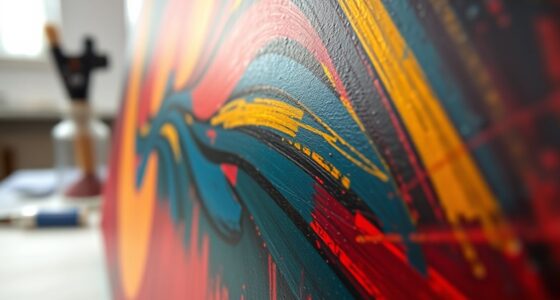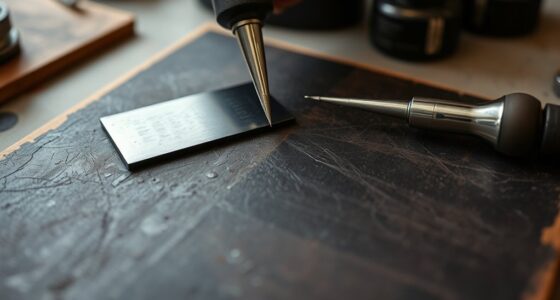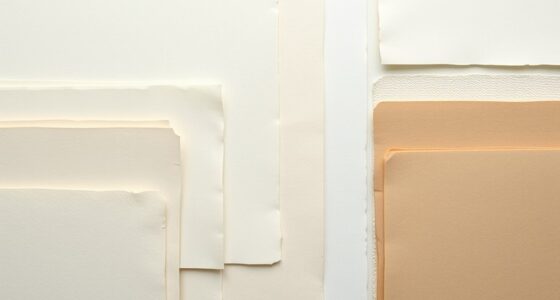To spot quality in a hand-pulled print, examine the paper’s texture, weight, and signs of aging, as high-quality prints use thicker, well-crafted paper that shows subtle irregularities. Look closely at the ink for consistent saturation, deliberate application, and signature techniques that suggest craftsmanship. Check for unique variations or imperfections that prove it was made by hand. If you explore further, you’ll discover more detailed clues to authentic, high-quality prints.
Key Takeaways
- Examine the paper’s texture, weight, and signs of aging to assess craftsmanship and authenticity.
- Look for consistent, smooth ink application and subtle tonal variations that reflect the artist’s hand.
- Identify irregular edges, uneven ink, or misalignments indicating manual printing techniques.
- Check the signature for authenticity—hand-signed signatures should be consistent and properly placed.
- Compare multiple prints for uniformity in texture, ink saturation, and technical details to confirm quality.
Inspecting the Paper Quality and Texture
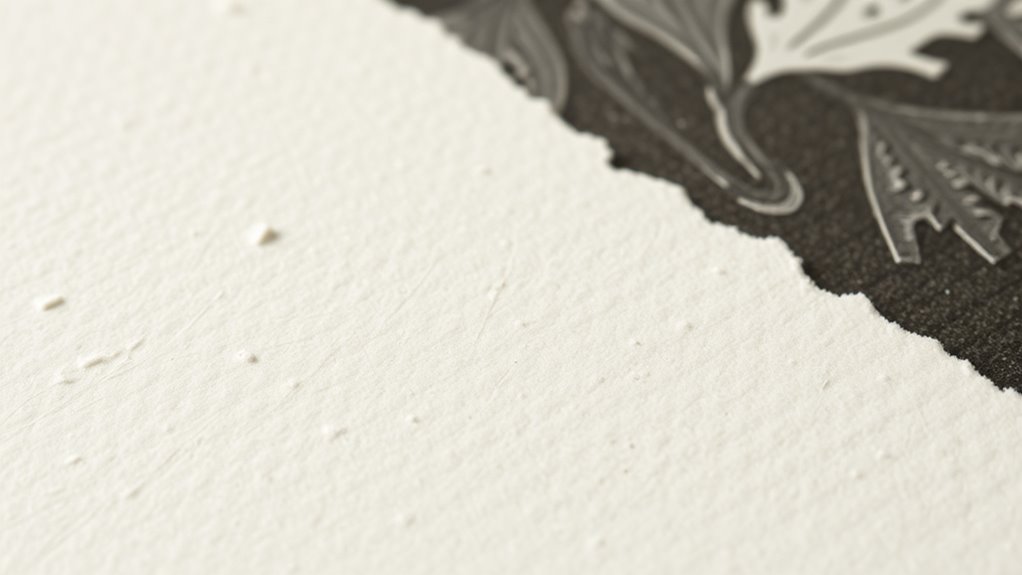
When evaluating a hand-pulled print, start by examining the paper quality and texture, as these elements reveal the print’s authenticity and craftsmanship. You should pay close attention to the paper texture, noting whether it feels smooth, rough, or textured. The tactile feel of the paper can indicate the level of care and skill involved in creating the print. High-quality hand-pulled prints often use thicker, more substantial paper with a unique texture that enhances their visual appeal. Avoid papers that feel flimsy or overly uniform, as they may suggest mass production. By carefully assessing the paper’s tactile feel, you gain insight into the print’s origin and value, helping you distinguish genuine hand-pulled works from lesser reproductions. Additionally, the recycling process and the type of paper used can influence the overall quality and environmental impact of the print.
Examining the Ink Application and Color Consistency
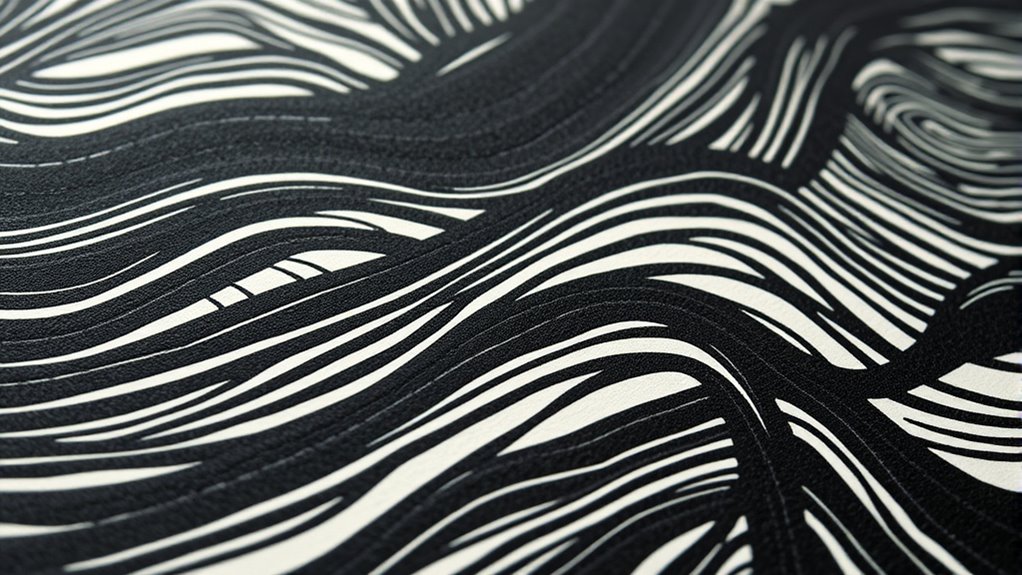
Careful examination of the ink application and color consistency can reveal much about a hand-pulled print’s quality and authenticity. Look closely at the paper textures beneath the ink—uneven or overly rough areas may indicate uneven ink saturation, which can compromise the print’s integrity. Genuine hand-pulled prints often display smooth, deliberate ink coverage, with consistent saturation across the image. Pay attention to color variations; authentic prints usually have subtle shifts or tonal differences, reflecting the artist’s hand. Avoid prints with overly uniform or flat color, as these can suggest machine reproduction. By scrutinizing how the ink interacts with the paper textures and checking for consistent ink saturation, you can better assess whether the print is a true hand-pulled piece or a less valuable reproduction. Additionally, understanding the visual principles behind printmaking can help you identify signs of craftsmanship and authenticity.
Analyzing the Edition Size and Signatures
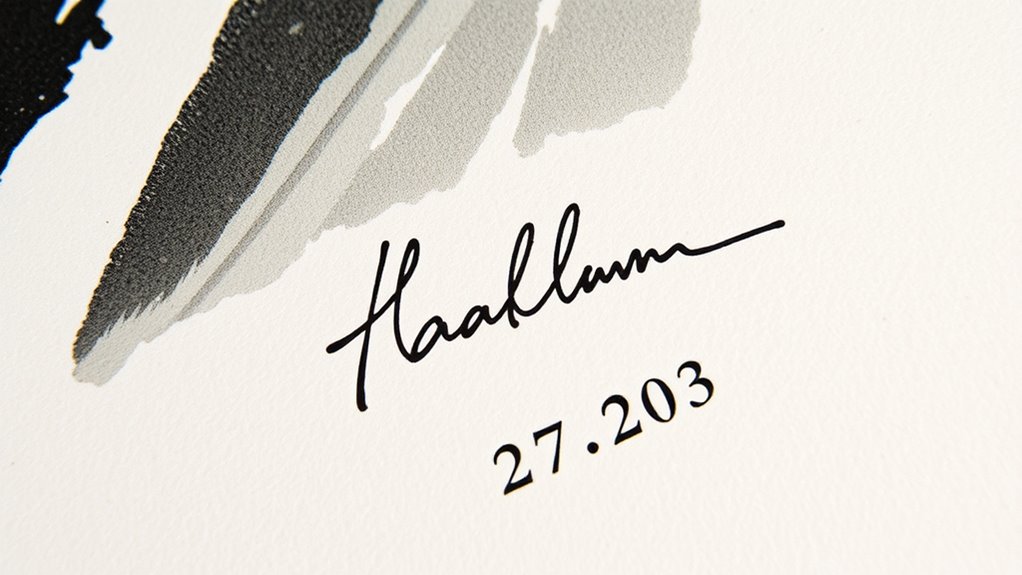
Examining the edition size and signatures can provide essential insight into a hand-pulled print’s rarity and value. Limited editions often increase a print’s desirability, so check how many copies exist. Fewer prints generally mean higher rarity, but also consider the paper texture—thicker, high-quality paper suggests a premium edition. Look closely at the signatures; signature styles can vary from artist to artist, and authentic signatures often show consistent handwriting, ink, and placement. Some artists sign each print individually, adding uniqueness, while others use a stamp or printed signature. Confirm that signatures aren’t just printed or stamped, as genuine hand-signed works are more valuable. By analyzing these details, you gain a clearer understanding of the print’s authenticity and worth. Paying attention to emotional support aspects, such as the artist’s reputation and the provenance of the piece, can also influence its perceived value.
Assessing the Clarity and Detail of the Image
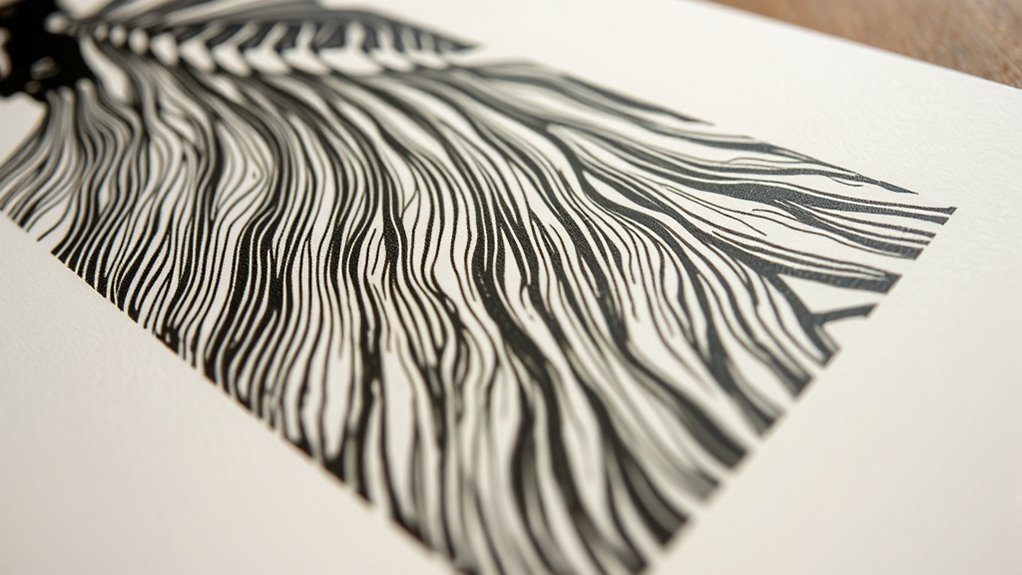
When evaluating a hand-pulled print, focus on the sharpness of lines and how clearly they define the image. Check for consistent ink density across different areas to guarantee even application. Pay close attention to fine details to see if they have been preserved without blurring or loss of clarity. Additionally, assessing the essential oils for print preservation can help ensure the longevity and quality of your artwork.
Sharpness of Lines
The sharpness of lines in a hand-pulled print directly reflects the quality of the printmaking process. Look closely at the brushstroke patterns—clean, crisp edges indicate careful control, while blurry or uneven lines suggest less precision. You can also perform paper fiber analysis by examining the print’s surface under magnification; high-quality prints reveal well-defined details with minimal feathering or blurring. Sharp lines should be clear and consistent, with no smudging or bleeding into adjacent areas. Pay attention to the progression between dark and light areas—if edges appear jagged or fuzzy, it points to a less refined process. Additionally, understanding the printmaking techniques involved can help identify the craftsmanship behind the work. Overall, a sharp, detailed line quality signifies skill and care in the print’s creation, ensuring a more collectible and enduring work of art.
Ink Density Consistency
Consistent ink density across a hand-pulled print indicates careful control during the inking process, which directly impacts the clarity and detail of the image. When ink coverage varies, it can cause uneven tones or blotches, obscuring fine details. Pay close attention to how the ink interacts with the paper fiber; a well-controlled pull results in uniform ink distribution, with smooth gradations. Additionally, check how the ink dries; even drying helps prevent smudges or unwanted variations that could compromise image clarity. Variations in ink density often point to inconsistent inking techniques or issues with ink application. A high-quality print shows steady ink density from start to finish, ensuring the image remains sharp, detailed, and true to the artist’s intent. Proper support hours during the printing process can also help maintain consistency and quality in the final product.
Fine Detail Preservation
Evaluating the clarity and detail of a hand-pulled print requires you to examine how sharply defined the lines, textures, and subtle gradations appear. Look closely at the print’s paper texture, which can influence the overall sharpness. Notice if the ink saturation is even, ensuring no areas are overly dark or faint. To assess fine detail preservation, consider:
- The crispness of intricate line work and how well it holds up without blurring
- The consistency of ink saturation across different tonal areas
- The visibility of subtle gradations and textures without loss of detail
- The way delicate textures, like fine cross-hatching or stippling, are rendered sharply and clearly
- The quality of paper used, as it impacts how well fine details are maintained during the printing process
These elements reveal the skill in the print’s creation and its overall quality.
Looking for Evidence of Hand-Printing Techniques
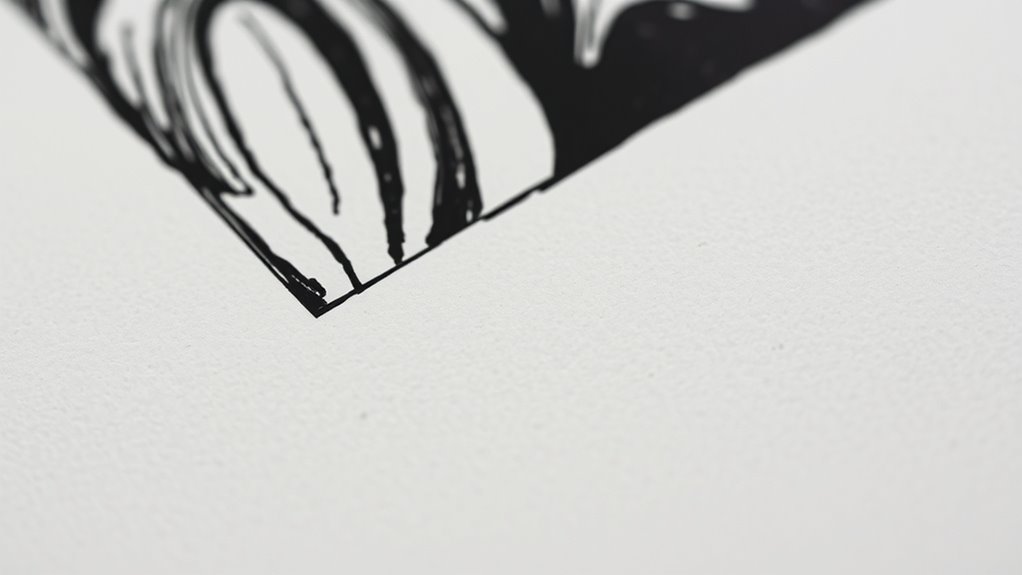
When examining hand-pulled prints, look closely for subtle variations that reveal the artist’s manual process. These differences often stem from historical printing methods, where each print was unique due to the hand-pressing technique. You might notice irregular edges, uneven ink application, or slight misalignments, all signs of manual craftsmanship. Modern reproductions, by contrast, tend to be more uniform and precise, lacking these imperfections. Hand-pulled prints often display variations in tone or texture that reflect the artist’s individual touch. Pay attention to the consistency of ink density and the presence of small flaws or irregularities, as these are strong indicators of authentic hand-printing techniques. Recognizing these clues helps distinguish genuine hand-pulled works from machine-made copies. Incorporating knowledge of antique techniques can also provide insights into the authenticity of historic prints.
Checking for Signs of Aging or Damage
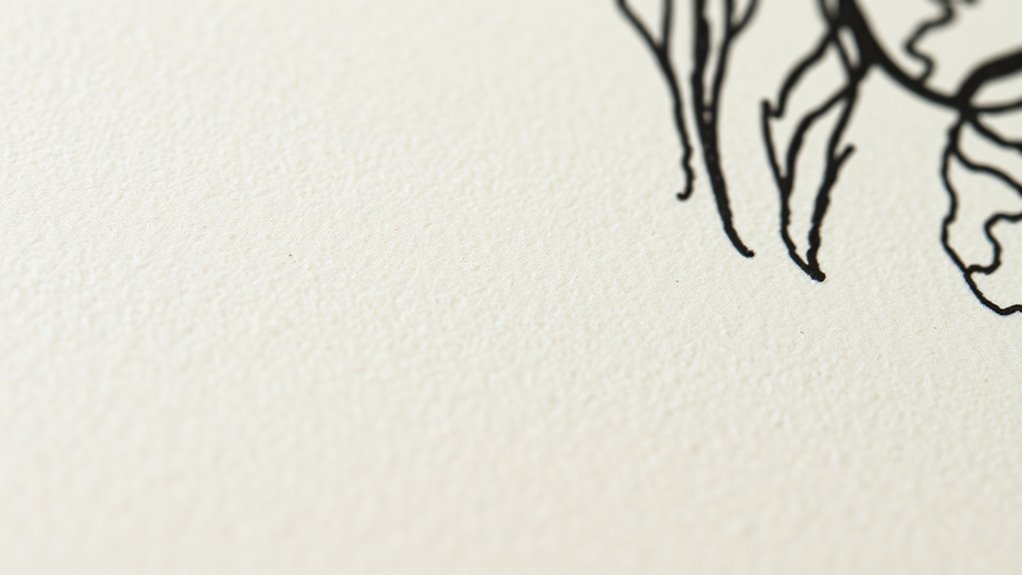
Examining a hand-pulled print for signs of aging or damage can reveal its true age and authenticity. Look closely for paper aging indicators like discoloration or yellowing, which suggest age. Check for damage signs such as tears, creases, or water stains that compromise the integrity of the print. To assess these factors:
- Inspect the edges for fraying or crumbling paper.
- Note any fading or uneven ink application.
- Look for surface irregularities like scratches or stains.
- Observe if the paper shows warping or puckering from moisture or handling.
Additionally, understanding the materials used in the print can help identify potential deterioration over time. These clues help determine whether the print has experienced extensive wear or damage, which can impact its value and authenticity. Recognizing these signs ensures you’re evaluating the print’s condition accurately.
Comparing Prints for Uniformity and Variations
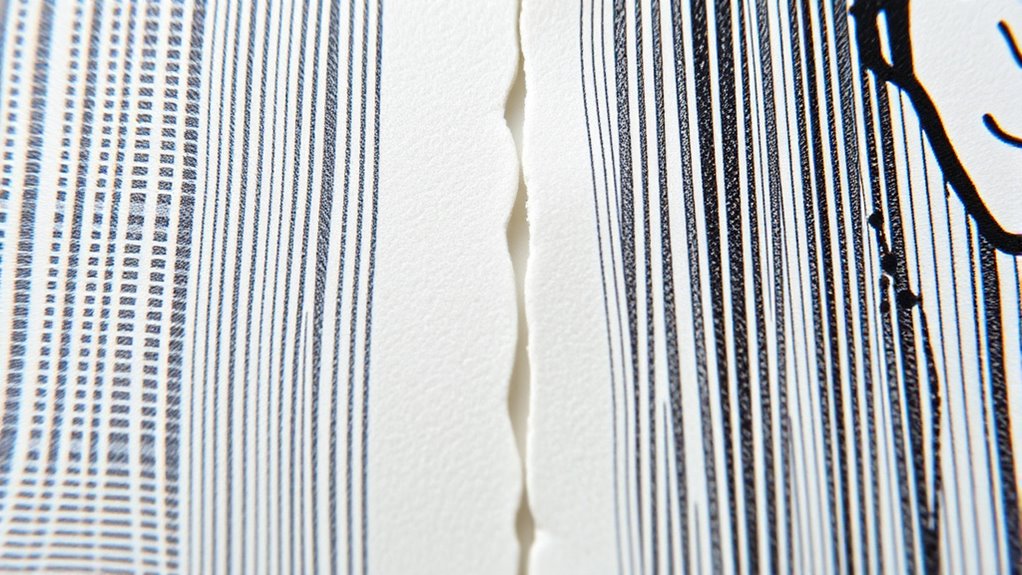
Comparing multiple hand-pulled prints reveals important differences and similarities that can help verify authenticity and quality. Pay close attention to the paper texture—consistent textures indicate careful, skillful printing, while irregularities suggest inconsistencies. Look at ink saturation across the prints: uniform saturation shows controlled application, whereas uneven areas may reveal shortcuts or rushed processes. Variations in paper texture or ink saturation can also point to different print runs or alterations. Additionally, understanding the texture of the textile medium can aid in assessing the overall quality of the print. By examining several prints side by side, you can identify these subtle cues, helping you distinguish genuine, high-quality works from copies or lower-quality reproductions. Remember, consistent paper texture and ink saturation across multiple prints are strong indicators of craftsmanship and authenticity.
Understanding the Artist’s Printing Method and Style
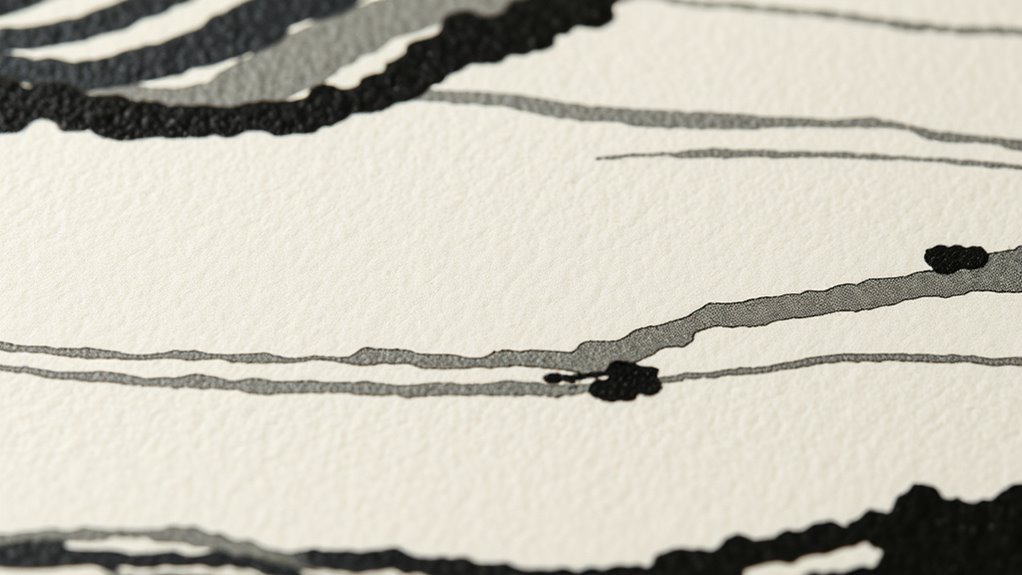
To truly recognize an artist’s work, you need to understand their signature techniques and strokes. Look for consistency in details across multiple prints, which reveals their unique style. Paying attention to these signatures helps you distinguish original hand-pulled prints from others. Recognizing tuning techniques can also help identify the authenticity and quality of the print, much like how enthusiasts determine the value of a well-modified Volkswagen.
Signature Techniques and Strokes
Understanding an artist’s signature techniques and strokes is essential for identifying the unique character of their hand‑pulled prints. Pay close attention to how they use stroke variations to create depth and movement. Recognize that different artists employ distinct signature techniques, such as:
- Consistent pressure changes that produce varied line thicknesses.
- Unique ways of blending or layering ink to add texture.
- Specific stroke directions that define movement or form.
- Techniques like scraping or scratching for texture effects.
These nuances reveal much about the artist’s style and skill. By studying their signature techniques and stroke variations, you gain insight into their process and authenticity, helping you distinguish original, high-quality prints from reproductions or less skilled works. Additionally, examining the texture and surface quality of the print can further indicate the artist’s technical approach and mastery.
Consistency in Details
Examining the consistency of details across a hand‑pulled print reveals much about the artist’s printing method and style. Look closely at areas where fine lines, shading, and textures appear. Consistent paper texture suggests the artist uses uniform pressure and paper choice, while variations may indicate inconsistencies in technique. Pay attention to ink saturation; uniform saturation shows control and precision, whereas uneven ink can signal rushed or inconsistent work. If details such as delicate lines or subtle gradations vary from one area to another, it may reflect differences in the artist’s method or skill. Recognizing these patterns helps you understand the artist’s approach, revealing whether they prioritize meticulous control or a more spontaneous style. Additionally, understanding automation’s role in business intelligence can help you appreciate how technology might influence the reproducibility and consistency of printmaking processes. This insight is key to evaluating the overall quality and craftsmanship of the print.
Artistic Style Signatures
Artistic style signatures are essential clues to deciphering an artist’s unique printing approach. Recognizing these signatures helps you distinguish authentic hand‑pulled prints from copies. Artists often develop signature techniques that become hallmarks of their work. To identify these, consider:
- Variations in ink application, such as uneven inking or intentional textures.
- Unique carving marks or patterns that reveal the artist’s hand.
- Specific color choices or layering methods characteristic of their style.
- Signature gestures or motifs consistently appearing across works.
Additionally, paying attention to printmaking techniques can reveal how the artist’s methods influence the overall signature of the print.
Verifying Authenticity and Provenance Records

To verify the authenticity and provenance records of hand-pulled prints, you’ll need to carefully review documentation provided by galleries, auction houses, or previous owners. Be cautious of digital reproductions that mimic original prints; authentic hand-pulled works typically lack digital signatures or watermarks. Check provenance records for detailed histories, including exhibition labels, previous sales, or certificates of authenticity. Be wary of prints that resemble commercial printing processes, which may indicate mass production rather than a unique hand-pulled piece. Cross-reference the documentation with expert appraisals or catalogs to confirm legitimacy. Authenticity isn’t just about paperwork—look for consistency in the print’s style and technique with the artist’s known methods. This diligence helps ensure your print’s value and originality. Additionally, understanding the printmaking process can aid in distinguishing genuine hand-pulled prints from reproductions.
Frequently Asked Questions
How Do I Determine the Rarity of a Hand-Pulled Print?
To determine the rarity of a hand-pulled print, look for rare print characteristics like unique color variations, limited editions, or special techniques. Check provenance documentation to verify its origin and history, which can also indicate rarity. You should research the artist’s catalog raisonné and editions, as well as any exhibition or publication records. These clues help you assess how uncommon and valuable your print truly is.
What Are Common Signs of a Reproduction Versus an Original?
When distinguishing a reproduction from an original, look for signs like inconsistent print texture analysis—originals usually have a richer, more nuanced texture. Forgery detection often reveals flat, overly perfect details, unlike hand-pulled prints that show subtle variations. Examine the paper quality and ink application closely. Originals typically show slight imperfections and depth, whereas reproductions tend to be uniform and lack the tactile richness you expect in authentic works.
Can the Artist’s Signature Help Verify the Print’S Authenticity?
Think of the artist’s signature as a fingerprint—unique and revealing. Signature analysis can help verify a print’s authenticity when you look closely at the style, placement, and consistency. Authentication marks, like edition numbers or stamps, also boost confidence. However, be cautious; signatures can be forged. Always cross-check with provenance and expert opinions to ascertain the signature truly belongs to the artist and confirms the print’s originality.
How Does Paper Aging Affect the Value of a Print?
You should consider how paper aging affects a print’s value by examining paper preservation and aging markers. Over time, paper can develop discoloration, foxing, or brittleness, which may decrease its worth. However, if aging markers are consistent with the print’s age and preservation efforts are evident, the impact might be minimal. Recognizing these signs helps you assess authenticity and condition, essential for determining a print’s true value.
What Tools Are Best for Inspecting Fine Print Details?
When inspecting fine print details, you should use magnification tools like a loupe or a microscope to see tiny elements clearly. Combine these with good light sources, such as a daylight or LED lamp, to highlight subtle nuances. Proper lighting and magnification help you identify brushwork, paper quality, and ink consistency, making it easier to assess the print’s authenticity and craftsmanship effectively.
Conclusion
By carefully inspecting these aspects, you’ll discover the secrets behind a print’s quality. Think of each detail as a brushstroke revealing the artwork’s true character. When you know what to look for, you’ll see through the surface and uncover authentic craftsmanship. Trust your eyes and instincts—they’re your best tools for recognizing a hand-pulled print’s genuine beauty. With practice, you’ll become a keen eye, catching the treasure hidden beneath the surface.


